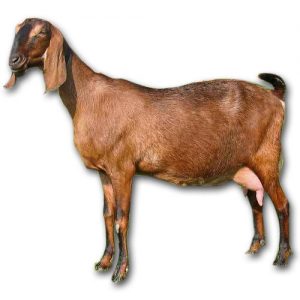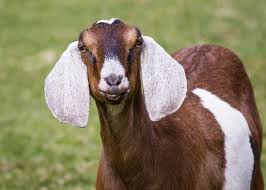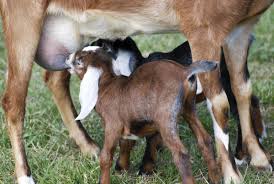Background
Anglo-Nubian goats (usually just called Nubian Goats in the United States) is categorized as a dual purpose breed for both dairy and meat however the main focus is dairy production. Nubians have superior butterfat production with an average of more than 4.6%. Nubian goats were originally developed in Great Britain as a dairy goat. The breed was derived from native goats crossed with goats from the Middle East and Africa. The defining characteristics are long pendulous ears which extend beyond the nose and round nasal areas as well as being vocal. Nubian goats are a large breed with weights of approximately 135 pounds for does and 175 pounds for bucks. Nubian goats are sociable and friendly and will call out to their owners to come give them some attention.
There is no color distinction required by the breed but typical colors are brown and black with black or white highlights. Some other color variations are also commonly seen such as frosted ears and moon spotted.



Nubian Herd at Triple Creek Farms
We run a small herd of registered Nubian goats. Our previous buck “The Magic Patrick” who was the sire for many of our does unfortunately passed away this summer. He was brown with white highlights and frosted ears. I am not a goat geneticist, but the frosted ears seems to be a dominate trait as all kids from Patrick had them. Our new buck is “Bowie” and is mostly black with some brown highlights and is very friendly. Our does consist of Annabelle who is brown with black highlights, Clover who is black with white spots and is considered “Moon Spotted”, and Rosie who is Clover’s daughter that has an unusual brown spotting. We have one Alpine goat mixed in with the herd named Esmeralda or Essie for short. I don’t know if it because she knows she looks different but she is a bit anti-social however she is the dominate doe in the herd.
Facts and Myths about goats
Goats will eat anything, even tin cans
Goats will eat a lot of things and I believe they would eat the paper off a tin can but they can’t eat metal or other hard objects. Goats are part of the Bovidae family which means they are ruminants and have cloven hooves and soft palate. Goats only haveeight teeth in the lower front of the mouth, the the upper part of the mouth have no teeth. Goats eat by grasping down on the hay or grass and ripping it off. As with other ruminants, the feed is chewed and swallowed and then later regurgitated as cud and chewed again. Goats are generally more picky than other livestock regarding the condition of the hay. Goats will often “nibble” new things but this doesn’t mean they will eat it.
Goats smell bad
Generally does and wethers (castrated males) have no discernible odor. Bucks can smell especially during the breeding season. How strong the odor is varies from buck to buck. Our current buck “The Magic Patrick” only has a slight odor during breeding season. The reason the bucks smell strong during breeding season is they pee on their heads much like a man would put on after shave. The odor is thought to help attract does and bring does into heat. The only real issue with the odor is that friendly bucks that like to rub there head on you will transfer the odor to your clothes. Hosing down the buck once a week during breeding season can help with managing the odor.
All goats with horns or goatees are male
Both does and bucks can grow horns as well as beards. The beards on does tends to be thinner and not be noticeable until about 3 years of age. We dehorn all the kids born on Triple Creek Farms for the safety of the goats. We use a goat size dehorning iron when the kids are about 2 to 4 weeks old. The iron cauterizes the area around the horn which cuts off the blood supply and the growing horn will fall off several weeks later. Their are several reasons why dehorning goats makes their lives safer: Firstly goats like to play, butt heads and push away other goats by their bodies, removing the horns prevents the possibility of severe injuries. Hornless goats are less likely to get caught in fences, vines and other obstacles. Goats will push their head past fences and other objects to get to the “greener browse on the other side” . Many times they can push their head in but then the fencing gets caught behind the horns and the goat is stuck. Finally it is safer for people if a goat butts them if the animal has been dehorned.
Goats will cut the grass
Goats will eat grass but is not their preferred forage. Like deer, goats are browsers and primarily like to eat buds and leafs off trees and bushes, and will eat grasses after there is no browse remaining. If a goat gets access to an area with shrubs and bushes it will eat the leafs and buds off and most times the small tree/shrub/bush will end up dying.
Goats are escape artists
Goats like to range and always think there is something better to eat on the other side of the fence. Like deer goats can jump extremely well and can squeeze through and under fences using gaps that one would think is too small to for an animal the size of a goat to make it through. Once a goat finds a spot to get through the fence they will continue to use the same spot to escape. Sometimes they make a bee line for the gap as soon as you put them back in the pen. Smaller goats and kids can sometimes be a real challenge to keep penned. Even four board fencing can have gaps too large for a goat to escape through. We have found stringing solid steel electrical fencing under the bottom board and in between the two lower boards will keep most goats in. The wire can be electrified or not depending on your preference.